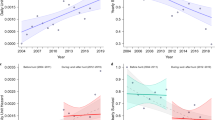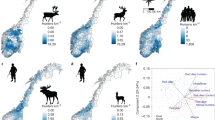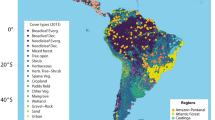Abstract
The potential impact of fox-hunting ban in Britain is a contentious issue1 that has been explored by Baker et al.2. They conclude that a suspension of lowland fox-hunting for nine months during 2001 made no difference to fox density in certain areas. We are not confident, however, that their analysis supports their conclusions — their study does not consider statistical power or account sufficiently for regional variation, and also uses an inappropriate statistic.
Similar content being viewed by others
Main
An analysis of statistical power is necessary to demonstrate the probability of detecting an increase in fox density of 10%, 20%, 30%, and so on, given the sample sizes and variability of the data. It seems likely that the power of Baker and colleagues' study to detect plausible effect sizes was low, whether by the analysis published or by any other test: the proper conclusion should be 'no evidence', rather than 'evidence of no effect'.
Moreover, a constant of 1.0 used (twice) in calculating the relative change in faecal abundance, R′, is large by comparison with average scat density, with the result that R′ is higher where faecal density before the hunting ban (imposed during the outbreak of foot-and-mouth disease (FMD)) is higher. For the same proportional increase in faecal density, R′ takes lower values for a low pre-FMD density than for a high pre-FMD density. For example, a 50% increase from a pre-FMD density of 5 faeces per km2 gives R′ = 0.008, whereas the same 50% increase from a pre-FMD density of 100 per km2 gives R′ = 0.085 (we have used log10; average faecal density was 50 faeces per km2 (ref. 3) and the average transect length was 6.9 km (ref. 2)).
If, as hypothesized by Baker et al., pre-FMD fox density had been suppressed in hunted squares, initial faecal density would be low in those squares, but would be predicted to increase during the suspension of hunting. Because of the low initial density, R′ would take low values in those squares. In an analysis of all squares, this would tend to mask differences between squares that show an effect and those that show no effect (for no change, R′ = 0). The consequences of this could influence the conclusions of Baker et al.
Finally, an earlier study contrasting three large regions of England and Wales concluded that hunting with dogs was the major part of an effective cull in one region, but not in the other two4. It is therefore appropriate to test for regional variation in the impact of hunting pressure, requiring that an interaction term be explicitly modelled. The upland regions where hunting with dogs is more likely to suppress fox densities were not represented in Baker and colleagues' study.
Only when these concerns are addressed can we concur that Baker et al. have clarified the effect of a hunting ban on fox populations.
References
Macdonald, D. W. et al. Managing British Mammals: Case Studies from the Hunting Debate (Wildlife Conserv. Res. Unit, Oxford, 2000).
Baker, P. J., Harris, S. & Webbon, C. C. Nature 419, 34 (2002).
The Mammal Society (http://www.mammal.org.uk).
Heydon, M. J. & Reynolds, J. C. J. Zool. 251, 265–276 (2000).
Author information
Authors and Affiliations
Rights and permissions
About this article
Cite this article
Aebischer, N., Baker, S., Johnson, P. et al. Hunting and fox numbers in the United Kingdom. Nature 423, 400 (2003). https://doi.org/10.1038/423400a
Issue Date:
DOI: https://doi.org/10.1038/423400a
This article is cited by
-
The value of a random sampling design for annual monitoring of national populations of larger British terrestrial mammals
European Journal of Wildlife Research (2014)
-
Reproduction of the red fox Vulpes vulpes in western France: does staining improve estimation of litter size from placental scar counts?
European Journal of Wildlife Research (2011)
Comments
By submitting a comment you agree to abide by our Terms and Community Guidelines. If you find something abusive or that does not comply with our terms or guidelines please flag it as inappropriate.



